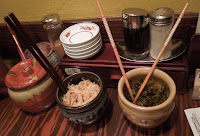 When you enter the shop, simply place your money in the vending machine on the right and choose from the picture menu. Each bowl of ramen comes with 2 pieces of cha shu, green onion, fungus and a serving of thin, straight noodles. The shop offers tonkotsu in 2 ways: regular and strong-flavour (with added miso paste). The top row of the vending machine, from right to left is: an extra serving of noodles (¥100), regular tonkotsu (¥700), strong-flavour (¥750), regular with a hard-boiled egg (¥800), strong flavour with a hard-boiled egg (¥850). Tsukemen is on the 2nd row from right to left: small (¥750), medium (¥750 - yes, you've read it right, the same price as the small), and large(¥850); followed by extra vegetables (¥100) and an extra egg (¥100).
When you enter the shop, simply place your money in the vending machine on the right and choose from the picture menu. Each bowl of ramen comes with 2 pieces of cha shu, green onion, fungus and a serving of thin, straight noodles. The shop offers tonkotsu in 2 ways: regular and strong-flavour (with added miso paste). The top row of the vending machine, from right to left is: an extra serving of noodles (¥100), regular tonkotsu (¥700), strong-flavour (¥750), regular with a hard-boiled egg (¥800), strong flavour with a hard-boiled egg (¥850). Tsukemen is on the 2nd row from right to left: small (¥750), medium (¥750 - yes, you've read it right, the same price as the small), and large(¥850); followed by extra vegetables (¥100) and an extra egg (¥100). | ||||||
| Torokeru purin |
 Once you have received your pink tickets and got your change back from the machine, the waitress hovering nearby will show you to your seat. Glasses of water will be placed in front of you and the waitress will take your tickets. This shop offers to prepare noodles to differing consistencies: harigane (extremely hard), barikatai (kind of hard), katai (hard), futsuu (normal), yawarakai (soft), bariyawarakai (very soft). Each seat usually has a card on it, with these options on the bottom right. If you have ordered ramen, this is the first thing that she will ask you. If you order beer, she will ask you how many glasses and you can simply count with your fingers. If you order pudding, she will ask before or after, so simply say 'ato' (after).
Once you have received your pink tickets and got your change back from the machine, the waitress hovering nearby will show you to your seat. Glasses of water will be placed in front of you and the waitress will take your tickets. This shop offers to prepare noodles to differing consistencies: harigane (extremely hard), barikatai (kind of hard), katai (hard), futsuu (normal), yawarakai (soft), bariyawarakai (very soft). Each seat usually has a card on it, with these options on the bottom right. If you have ordered ramen, this is the first thing that she will ask you. If you order beer, she will ask you how many glasses and you can simply count with your fingers. If you order pudding, she will ask before or after, so simply say 'ato' (after).After stating your preferences to the waitress, you'll notice 3 jars in front of you. These are the appetizers and are meant to occupy you until your order arrives. Simply use the chopsticks to scoop some into the small white dishes. Do not use these chopsticks to eat with. The disposable chopsticks are in the rectangular box under the white dishes.
 |
| Tonkotsu ramen |
 |
| Tsukemen comes with green onion, bamboo shoots, seaweed and pork. |
The restaurant itself is a bit cramped, with only 2 tables at the back. The majority of the seats are stools at the counter which runs most of the length of the restaurant. However, the counter seats allow you to see directly into the kitchen where the staff can be seen flinging ramen noodles into the air. It's also comforting to see the cooks place the already clean bowls into boiling hot water right before they fill it with noodles and broth. Hygiene is sometimes a bit questionable at ramen shops- I've come across places where I've wondered if the bowls are only cleaned once a day and even then it's probably only done by the cockroaches during the night. In a typical ramen shop kitchen, the water from the noodles is flung to the floor with abandon and this is the case with Tasunoya, but it's by far the cleanest ramen shop I've been to. It's a good place to eat but not to linger and chat, as there really isn't the space to relax. But the staff are friendly, the prices are reasonable, the food is great and the entire restaurant is non-smoking. If you're near Shinjuku station, you really must make the 8-minute walk and check out this restaurant.
For a general map of my restaurants, visit : My map


No comments:
Post a Comment